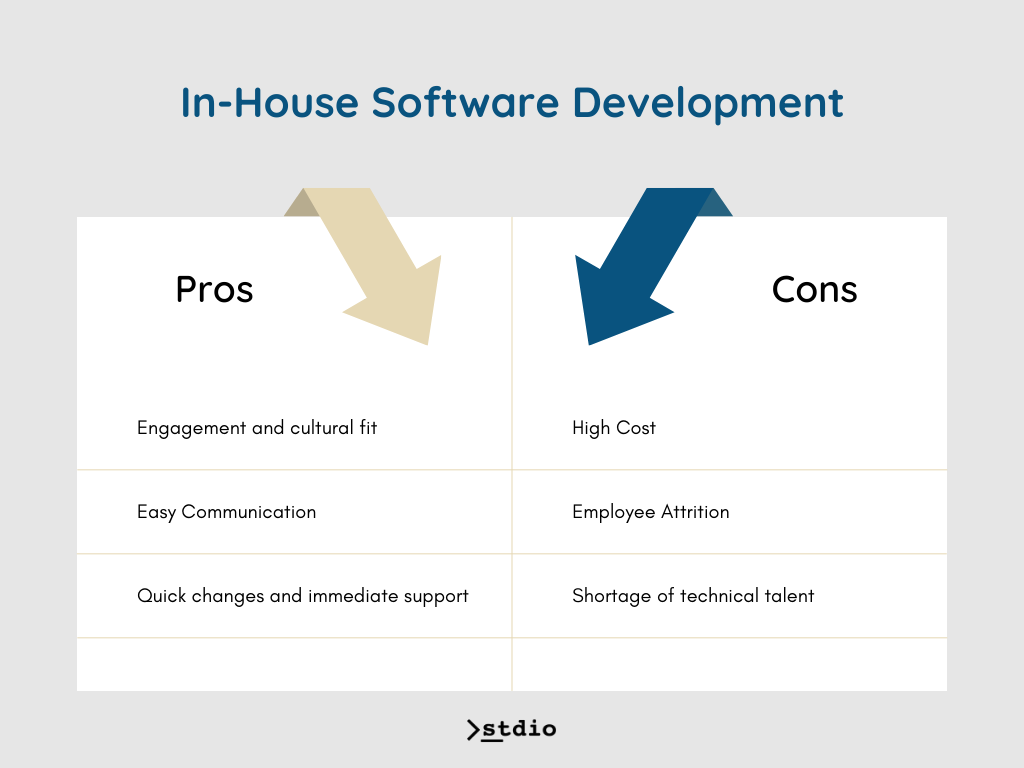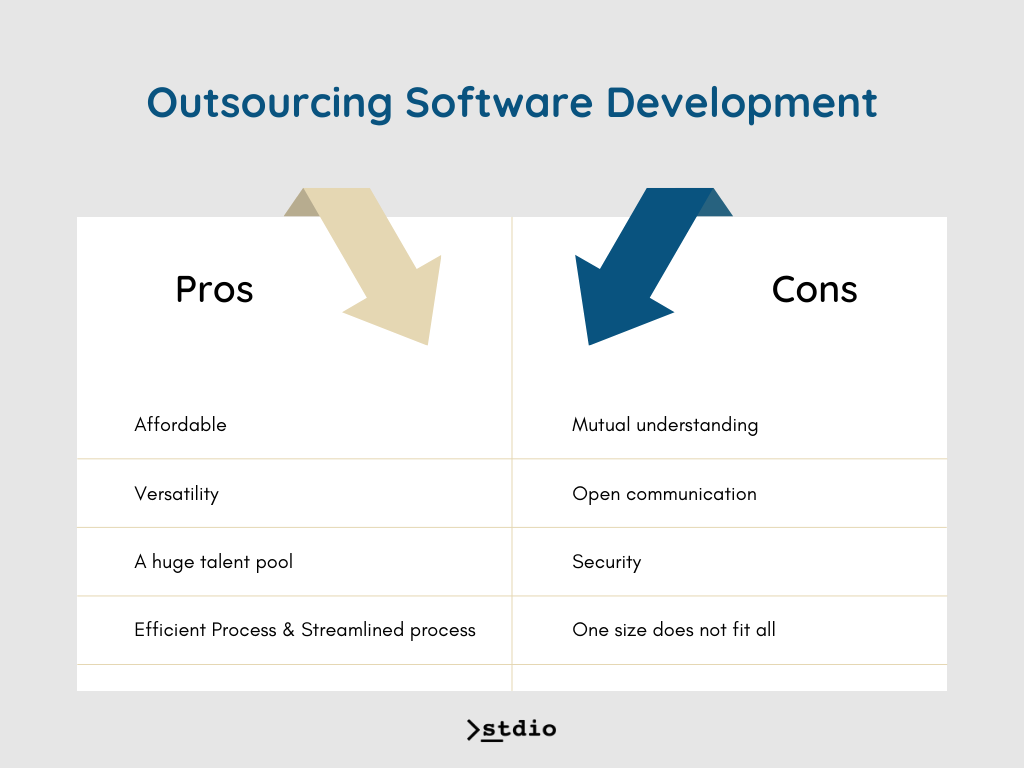Discover the contrasts between in-house and outsourcing software development for your business. Gain insights into organizing the development process effectively to make informed choices.
Finding professional tech personnel is no easy task, especially when time and budget are limited. Consider this: the global outsourcing market reached $92.5 billion before the pandemic, and those numbers have only skyrocketed since the world went digital. That’s why companies, regardless of size, are turning to outsourcing software development services to reduce administrative expenses and product development costs. Plus, think about the benefits of accessing a rich talent pool from around the globe.
For long-term collaboration, consider choosing a local team of developers. It’s important to note that hiring an in-house team requires additional time and financial investment. You need to carefully select the right talent, provide training, and follow the development process diligently.
In-House vs Outsourcing Software Development – Evaluating the Benefits and Drawbacks
Selecting the best option is subjective and doesn’t have a definitive answer. However, it can be achieved by making informed decisions that align with your goals, time constraints, and budget. Let’s compare outsourcing resources with building an in-house development team for your project. This analysis will provide a clear understanding of the advantages and disadvantages of each approach.
Overview of In-House Software Development
Insourcing, also known as in-house software development, involves hiring local experts for your company instead of outsourcing. By employing developers to work alongside you, you can ensure greater control and collaboration.
In-house development is straightforward. You select a team with specific skills to achieve goals collectively.
Building an in-house team can be time-consuming and challenging. However, with careful planning and execution, you can establish a dedicated team that supports your future endeavors.
By leveraging in-house development, you gain ownership and foster a collaborative environment for long-term success.

Benefits of In-House Development
Employee Engagement and Cultural Alignment
A company’s success depends on a passionate team that embodies its core values. In-house software development allows you to assemble a team aligned with your company’s goals. They understand business needs and embrace their responsibility to achieve objectives. This engagement with operations fuels motivation to deliver exceptional results and create value.
Effortless Communication
A cohesive team working together in a shared physical space benefits greatly from clear communication. By directly conversing with fellow employees who share a common goal, the need for excessive email exchanges is eliminated. This not only prevents misunderstandings but also enhances the overall efficiency and productivity of the team.
Rapid transformations and prompt assistance
Having an in-house team of software developers makes it more convenient to investigate and promptly address bug fixes and issues, ensuring efficient problem-solving without any delays.
Disadvantages of In-House Development
It at a high cost
The cost of hiring an in-house team can pose a challenge that may lead you to consider outsourcing. In-house development is generally more expensive compared to collaborating with outsourced resources. This is primarily due to the inclusion of hidden expenses such as rent, taxes, software, hardware, and more in the overall cost of hiring in-house talent. Additionally, there are supplementary costs like employee training, sick days, and company benefits that significantly contribute to the total expenditure.
Employee Attrition
Software developers often switch jobs frequently, driven by the high demand for talent in the industry. They may seek better working conditions elsewhere, which poses a common challenge for in-house resourcing. This can result in time loss, as finding a new resource for an ongoing project is a time-consuming process that can impact project completion.on.
Shortage of technical talent
In’s market, where there is a significant demand for IT specialists and software developers, finding the right talent has become increasingly challenging. Not only must these professionals possess the necessary skills, but they must also fit within the allocated budget, posing a challenge for many companies.
Overview of Software Development Outsourcing
Affordable
Across the globe, a vast network of established outsourcing companies exists, providing resources at affordable rates. By engaging with these companies, you can access top talent and expertise for your ongoing projects without exceeding your budget.
Versatility
Outsourcing experts enable businesses to scale their development efforts to meet fluctuating demands and adapt to changing requirements. You have the flexibility to increase your team size when needed during the development process, or decrease it based on project completion timelines. This approach ensures efficient resource allocation and allows for seamless adjustment to meet your business needs.
An enormous reservoir of talent
By tapping into the world’s largest outsourcing companies, you gain the opportunity to select top talent from across the globe. Unlike the lengthy process of in-house hiring, outsourcing allows you to secure the right expertise within a matter of days. With outsourcing, the possibilities are endless — you can explore a wide range of options and find the perfect fit for your needs. professionals with different skills and experience to work with you.
Accelerated project delivery
Hiring outsourcing specialists can save you time on recruitment. Additionally, collaborating with an augmented development team allows for flexible project timelines. This enables you to launch your product earlier, while also reducing development costs.
Efficient Process
You can rely on outsourced professionals to provide a well-established development process. With their experience on diverse projects, they have the expertise to meet your business goals. The processes are meticulously set up by professionals, ensuring optimal structure and efficiency.

Drawbacks of Outsourcing Software Development
Mutual understanding and open communication
When team members are spread across different geographical locations and companies, communication issues can hinder the effectiveness and efficiency of the team. Language barriers and varying time zones are common challenges faced by outsourced development teams. However, vendors often mitigate these problems by scheduling team meetings and utilizing email and messaging platforms to ensure continuous connectivity.
Security
As mentioned earlier, when outsourcing resources, there is a lack of face-to-face communication. Consequently, you may lose control over the development process and face the risk of data leakage. However, by collaborating with reliable vendors and implementing a non-disclosure agreement, you can establish clear rules and penalties for any data breaches committed by the resources working on the project. This ensures a more secure and controlled environment for your development endeavors.
One size does not fit all
Although training your in-house team can help them understand your business goals, outsourcing may lack control over the processes of the experts, which can lead to some challenges in the future.
Mastering the Art of Outsourcing: A Guide to Success
Outsourcing software development demands careful planning and time investment. Here are effective strategies to ensure successful outsourcing!
Discover the perfect outsourcing collaborator
Ensure that you select a partner who not only aligns with your business requirements but also possesses a proven track record of delivering projects reliably and punctually. Conducting thorough research is the key to finding the perfect development partner. Utilize directories like Clutch.co to assess the company’s suitability as a reliable partner. Look into their industry experience, transparency, scalability, and other qualities that define a dependable outsourcing service.
Explore outsourcing models to understand their intricacies
There are three common models for outsourcing: time and material, fixed price, and monthly retainer. These models offer different approaches to suit various needs and preferences.
1/ Time and Material
In this outsourcing engagement model, there is no predefined budget. Instead, you pay based on the total number of hours dedicated to the project and the materials or technology stack utilized for development.t.
2/ Fixed price
The model operates under a self-explanatory name, indicating its utilization of fixed price bidding for a specific model. This approach disregards the time and resources invested in the development process.
3/ Monthly Retainer model
In this model, clients bear the cost for a predetermined number of hours. This approach is ideal for businesses engaged in ongoing projects that necessitate a dedicated team to achieve their objectives.
Additionally, collaborating with partners who share similar mindsets can amplify the expertise of your team, thereby enhancing overall outcomes.
Clearly your expectations
Effective communication is paramount! It cannot be emphasized enough how crucial clear communication is for a successful development process. Given that your development team operates independently, it is vital to ensure that both your time and theirs are utilized efficiently, without any wastage. Don’t hesitate to ask questions and always be prompt in addressing your team’s queries.
In-House versus Outsourcing Software Development: Concluding Remarks
When comes to making the right choice for your project, there are several factors to consider. However, by meticulously assessing your resources and performing a thorough analysis of your business needs, you can ensure that your decision is the correct one.
If you have a software project, we invite you to reach out to STDIO ASIA for top-notch software development services.



Leave a Reply